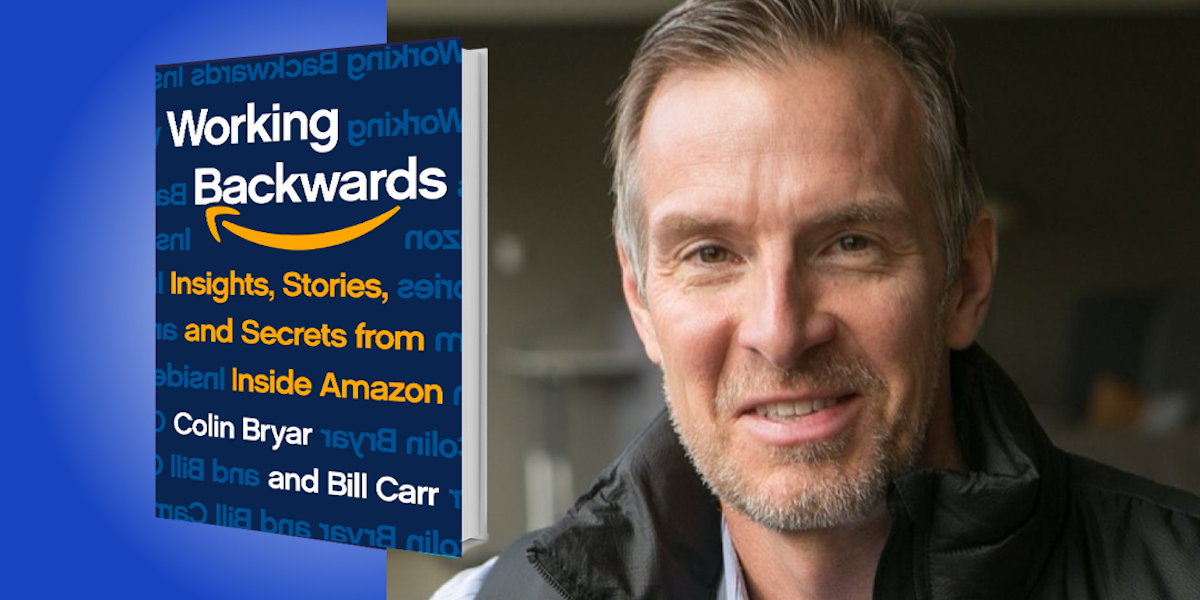Colin Bryar joined Amazon in 1998 and spent the next 12 years as part of Amazon’s senior leadership team as the company grew into a global powerhouse and innovator. Colin served as a Vice President at Amazon, and was Chief of Staff to Jeff Bezos for two years. Bill Carr joined Amazon in 1999 and spent more than 15 years with the company. As Vice President of Digital Media, Bill launched and managed the company’s global digital music and video businesses, including Amazon Music, Prime Video, and Amazon Studios.
Below, Bill shares 5 key insights from their new book, Working Backwards: Insights, Stories, and Secrets from Inside Amazon (available now on, well, Amazon). Download the Next Big Idea App to enjoy more audio “Book Bites,” plus Ideas of the Day, ad-free podcast episodes, and more.
1. Amazon has created an “invention machine.”
Amazon has built some incredible products and services over the years, ranging from cloud computing to digital media devices to an amazing e-commerce service. And they were all created with a new way of thinking about developing products and running a company. As Jeff Bezos once said: “Amazon has created an invention machine.” Simply put, this invention machine is a set of 14 leadership principles that are reinforced by five scalable, repeatable processes. These processes include how the company conducts its hiring, how it conducts meetings and makes decisions, how the company develops new products, how they organize teams, and finally, how the company manages metrics and businesses to achieve excellence.
2. You, too, can build your own invention machine.
The Amazon way of thinking and doing business can be replicated—and it really works. These processes and principles have been used for businesses that started off with zero employees and zero revenue, and have scaled all the way up to hundreds of thousands of employees and billions of dollars in revenue. And importantly, these processes can be applied to any kind of organization.
3. Amazon has developed leadership principles with teeth.
We’ve all been at companies where they have principles enshrined in posters on the wall—maybe a picture of a crew rowing, with the word “Teamwork” beneath them. But that poster is completely meaningless in terms of how the company thinks about operating. Amazon, on the other hand, has gone to great lengths to carefully document and uncover, “What does a role model leader look like at Amazon?”
If you Google “Amazon leadership principles,” you can read all 14 of them yourself. The point of these principles is not for you to take them and apply them directly to your company, because every company is different. Instead, take the time to uncover what makes a great leader at your company, and also understand what skills and capabilities people will need to help achieve your vision for the company. Document and describe these in the form of principles that you can then apply to the company’s daily processes.
“Discover, document, and communicate your company’s leadership principles, and knit them into everything you do.”
4. Amazon has developed five repeatable, scalable processes to run the company.
- The bar raiser process: This is how Amazon conducts interviews and makes hiring decisions. They require each interviewer to interview each candidate on specific criteria only, and to divvy that up among the different interviewers. They also add a subject matter expert to every interview group called the “bar raiser” who helps to coach interviewers and guide debrief meetings. This person can also veto a hire, helping ensure that the hiring manager is, in fact, raising the bar.
- How to conduct meetings: Amazon decided that PowerPoint was an inefficient way to conduct meetings. Instead, they use Word documents or narratives. After all, you can read 70 times faster than you can listen to information. And it’s a lot harder to write a Word document than it is to make a PowerPoint, so it forces that presenting team to distill the information and get the audience up to speed as quickly and effectively as possible. The first 20 minutes of the meeting are spent reading the document, followed by 40 minutes of discussion.
- Working Backwards PR/FAQ: This is the process that Amazon uses to develop new products. They actually start by writing a press release, which gets them hyper-focused on how the product is going to matter to customers. Once they identify a great product idea and a press release, they go through the FAQ (frequently asked questions) that address all of the different issues, conditions, and barriers that must be addressed in order to bring this product to life.
- The single-threaded leader model: This is how Amazon organizes teams. They put together small, agile teams that are each focused on a single specific area, product, technology, or solution. To quote Amazon Senior VP Dave Limp, “The best way to fail at inventing something is by making it somebody’s part-time job.” So when the company conceives of a new product idea, they create a whole new team that is separate and autonomous from the existing business. This team is undistracted by the burdens of managing that business, and they can focus exclusively on launching that new product or service.
- Input metrics vs. output metrics: Output metrics are things like revenue, free cash flow, gross margin, and other financial metrics. Input metrics are the things that the company can actually control, like how many products are available, how competitive their prices are, and how easy it is to discover them. Amazon is hyper-focused not on the outputs, but on these inputs—questions like, “How do we lower prices?” and “How do we add greater selection?” By focusing on those inputs, the process improves, and that results in the right outputs. In short, focus on your inputs, not your outputs.
5. It’s surprisingly easy to get started.
This all may sound daunting—after all, Amazon is a big company, and you may doubt your ability to do what they do. But it’s actually quite easy, and there are a few things you can do to get going. The first is to go out, discover, document, and communicate your company’s leadership principles, and knit them into everything you do. The second is stop using PowerPoint to make decisions and conduct meetings, and instead start using written narratives or Word documents. And the third thing you can do is when you’re at the start of a new product development process, use the Working Backwards PR/FAQ process.
For more Book Bites, download the Next Big Idea App today:
































